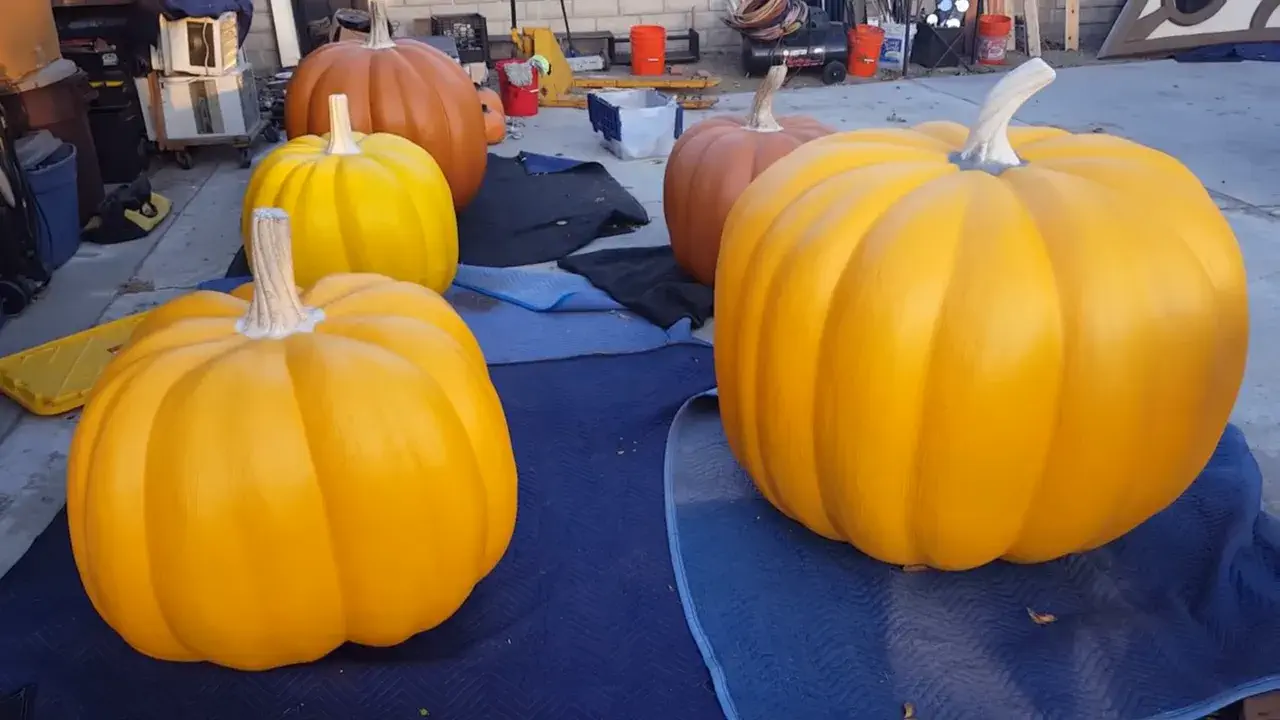Fake pumpkins, widely used for decoration, especially during autumn and Halloween, are typically made from materials like polystyrene foam, plastic, and fiberglass.
- Polystyrene Foam: These are lightweight and easily customizable but can be blown away easily.
- Fiberglass: The heaviest and most durable, fiberglass pumpkins offer a more realistic look and feel.
Fake pumpkins face two primary challenges: wind displacement and theft.
Their lightweight nature makes them susceptible to being carried away by strong winds or easily picked up by passersby.
First, make a small cut at the bottom of the pumpkin. Then, insert a wooden shim into the slit you’ve created. This provides a pointed end that you can drive into the soil, securing the pumpkin in place.
Weighing Down Uncarved Foam Pumpkins:
Required Tools: A Porter Cable drill, Kata hole saw set (sizes 3/4″ – 6″), a funnel, plastic bags (use freezer bags for small pumpkins and lawn bags for larger ones), scissors, and sand. Ensure you work in a well-ventilated area due to the potential for dust generation.
Procedure:
1. Position the foam pumpkin on your lap, taking care to not damage the stem, which is fragile and prone to breaking. Utilize a marker to designate the spot on the bottom of the pumpkin where you will drill; exercise caution here as applying too much pressure could compromise the structural integrity of the pumpkin, causing it to burst or break apart.
2. Using the designated hole saw attached to your drill, carefully create an opening at the marked spot. The process should be gradual to avoid applying undue pressure.
3. Then reach the middle part of the plastic bag to the top of the pumpkin with a thin stick, adjust the bag along the pumpkin’s inner surface using the stick to ensure it fits snugly within the contours of the pumpkin.
4. Insert the funnel into the hole you’ve drilled. roll the edge of the paper (if youre using paper) to fit. Gradually pour sand into the funnel, filling the plastic bag inside the pumpkin. It’s crucial to maintain a steady flow of sand and not remove the funnel prematurely to avoid sand spillage and ensure there are no air pockets within the bag once filled.
5. After filling, twist the excess portion of the plastic bag protruding from the pumpkin to seal the sand inside. Secure this with a robust knot to prevent any leakage of sand.
6. Trim away any excess bag material using scissors, ensuring the cut is close to the knotted section without compromising the seal. Tuck the remaining portion of the bag into the pumpkin through the hole to keep it out of sight and adjust it off to the side within.
One of the most straightforward ways to secure fake pumpkins is by using weight bags or sandbags (pebbles). These can be placed inside the pumpkin if it’s hollow or attached to the base to add stability.
- Base Attachment: For solid pumpkins, attaching weight bags to their base can help keep them grounded.
– Opt for weather-resistant strings or wires, like nylon or coated metal.
– Consider the color and thickness to ensure they blend with the pumpkin and surroundings.
This approach involves securing the pumpkins by tying them to a stable structure, such as a fence, tree, or heavy garden fixture.
Securing Technique
– Tie the pumpkin stem securely, avoiding damage.
– Anchor the other end to a solid structure, keeping tension consistent.
– Cut a small hole at the bottom or back of the pumpkin (less visible areas).
– Fill it with a heavy material like sand, small pebbles, or even dry rice. This adds weight and lowers the pumpkin’s center of gravity, making it less likely to blow away.
– Seal the hole with strong tape or glue to keep the filling material inside.
Attach heavy-duty Velcro strips to the bottom of the pumpkin and then secure it to a surface that has the corresponding Velcro piece attached. This allows for easy removal and repositioning.
– Use clear fishing line or thin wire to tether the pumpkin to a stable element on your porch, like railings or columns.
– Ensure the tethering material is tight enough to hold the pumpkin in place but not so tight that it causes damage.
Position the pumpkin in a corner or against a wall where it’s less exposed to wind.
– Use other decorative elements like potted plants, furniture, or larger decorations to create a windbreak around the pumpkin.
– Place the foam pumpkin within a larger, heavier display. For example, set it among a group of real pumpkins, which are heavier, or inside a decorative basket filled with stones or other weighty materials.
Locations under overhangs or behind porch columns can offer more protection
Beyond basic tethering, there are more advanced techniques involving stakes and ground anchors which provide additional stability.
You can glue or otherwise attach your fake pumpkins to a heavier base, such as a wood plank or a decorative plate. – Apply the adhesive evenly for a strong hold.
– Outdoor-grade adhesives are preferred for their durability.
– Ensure the base is wider than the pumpkin for better stability
Building a larger display around your fake pumpkins can be a visually stunning and practical solution. By integrating the pumpkins into a broader theme, they become part of a cohesive unit, which is inherently more stable and less prone to being displaced.
– Select a theme that complements the season or your personal style
– Arrange these elements in a way that looks organic and intentional, rather than merely functional.
– Consider temporary covers or shelters to protect the pumpkins from harsh elements.
Yes, natural elements like rocks, branches, or heavy plants can be used to stabilize fake pumpkins.
Positioning your pumpkins inside a decorative container or under a glass cloche can protect them from being blown away.
Fake pumpkins can be incorporated into themed displays, nestled among autumnal foliage, or used as centerpieces in outdoor table settings.


